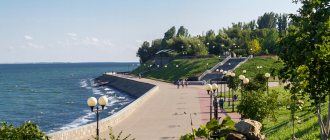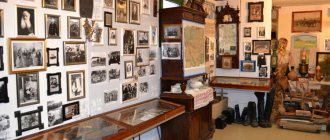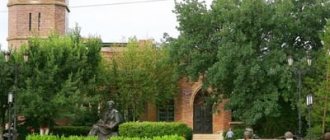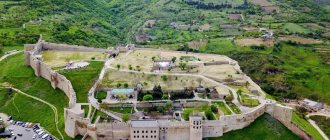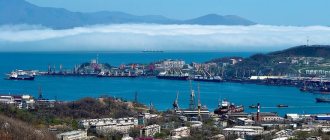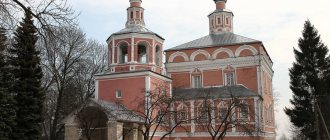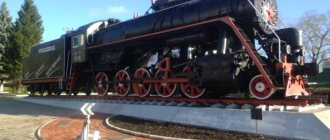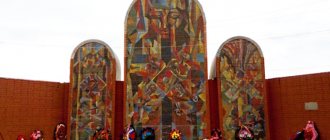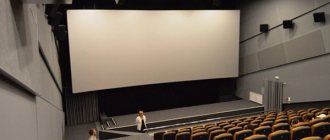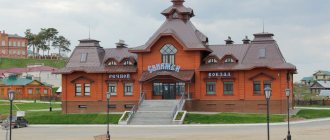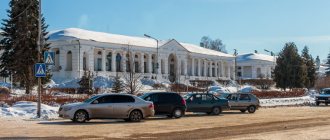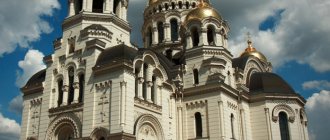Although Nevinnomyssk is small in area, this did not stop it from being divided into many districts. When I moved here, I had no problem understanding the intricacies of the city’s administrative division within the third or fourth day.
It looks like this:
- Center,
- PRP,
- spare parts,
- Head,
- MZhK,
- Red Village,
- Comet,
- Mill,
- Old city,
- Rozhdestvenka,
- Pravokubansky,
- House of life
- Factory.
On the map I marked the most important districts of Nevinnomyssk.
I’ll tell you in more detail about some of the most interesting areas to visit.
Museum of Local Lore
The gallery was opened in May 1957 as the "Combat Hall of Fame". After this, the museum changed its educational focus several times, and in 1978 a new building was allocated for it. Since 1994, it has been located in the central part of the city in the former building of the House of Celebrations.
The museum consists of three halls. The first is dedicated to the history of the city’s development, from the first settlers to modern Nevinnomyssk. In the second hall various art exhibitions are constantly held, and in the third there is an exhibition on the theme of the Great Patriotic War.
Location: Gagarin street - 43B.
General information
If you study the history of these ancient places, you may get the impression that all the nomadic peoples of the world passed through these lands. Archaeological finds confirm this. Traces of the Scythians, Khazars, Sarmatians, Alans, Huns, Avars, Cumans, Pechenegs, Mongols and other peoples were found here. This was probably due to the good climate, extensive pastures, the presence of one of the branches of the Great Silk Road and the proximity of the sea with its ports. Until 1778, these lands belonged to the Crimean Khanate, and then became part of the Russian Empire. Throughout the second half of the 18th century and into the 19th century, there were constant skirmishes and battles between local tribes and the Cossacks.
In the 19th century, a railway passed through the village, which caused a sharp industrial growth of the city.
Then there was a civil war, in which the city of Nevinnomyssk took an active part. Two warring forces clearly emerged - the workers of the city for Soviet power, and the Cossacks for the White Guard.
In 1921, Nevinnomyssk experienced dispossession and repression and famine. Nevinnomyssk received city status in 1939.
During the Great Patriotic War, Nevinnomyssk was occupied from August 1942 to January 1943 and suffered significant destruction.
In the post-war years, the construction of large industrial enterprises began in the city, which became city-forming enterprises. Some of them were declared All-Union construction projects.
Currently, the city is a major transport and industrial center. Its population is 116 thousand people.
Interesting Facts:
- * In 1787, at the confluence of the Kuban and Nevinka rivers, the first military fortification was built - the Nevinnomyssk redoubt.
- * Initially, the Cossacks of the Khopersky regiment from the Stavropol, Moscow and Don regions moved to the newly formed village. Later from other provinces.
- * In 1850, the future Emperor Alexander II visited the village of Nevinnomyssk.
- * From 1872 to 1875, construction of a railway was carried out in Nevinnomyssk.
- * In 1927, electricity was installed in the village.
- * In 1936, construction began on the Nevinnomyssk Canal, which adorns the city to this day.
- * In 1960, construction of a nitrogen fertilizer plant began, declared an All-Union Komsomol shock construction project.
- * In June 2002, the city experienced a massive flood. Most of the bridges across the Kuban River were destroyed and several large areas of the city were completely flooded.
- * In May 2012, the city experienced a magnitude 4 earthquake. Fortunately there were no casualties.
- * In 2022, Nevinnomyssk was included in the Guinness Book of Records. The reason was that 4,573 people got into a push-up position on the bridge over the Kuban River!
The participants held this pose for one minute, and the record was recorded.
"Book of Memory"
The obelisk is made in the form of a book almost 3 m high and 13 m wide. On the pages of the book, made of stone, are engraved the names of almost 500 Soviet soldiers, most of whom were local residents who died in the war for the defense and free life of the city of Nevinnomyssk. The monument was opened in 2000 on the 55th anniversary of the celebration of the victory over the Nazi invaders.
Memory of the heroes of distant battles
A monument to General Ermolov, a participant in the wars with France in 1805, 1812 and military operations in the Caucasus, was erected.
The talented commander was both a wise politician and an active reformer. Heading the military forces of the Caucasian Corps, he did a lot for the reconciliation and development of these regions.
In 1918, Ivan Kochubey, having gathered a detachment of poor Cossacks, fought his way to the Tikhoretsk station, where he was enlisted in the Red Army. He led his detachment into battle against the White Guards in the North Caucasus. A talented organizer, he carried out brilliant military operations against the units of Shkuro, Pokrovsky, and Erdeli. Died at age 26. In 1959, a monument was erected to him, which is considered a landmark of the city of Nevinnomyssk.
"Eternal Glory"
This monument was opened in November 1967, on the day of the 50th anniversary of the October Revolution, in the very center of the city. It, like the “Book of Memory,” is dedicated to the soldiers who died during the Second World War, as well as during the First World War. On the day of the opening of the monument, a capsule was placed inside it containing soil from the sites of heroic battles of Soviet soldiers. The Eternal Flame, brought from Mamayev Kurgan, was lit next to the obelisk. In May 1975, a ceremonial burial of urns with the ashes of fallen soldiers took place at the base of the monument.
Old city
The name speaks for itself. It was this area that was once the city itself and it was around it that modern Nevinnomyssk began to grow.
I would call a characteristic feature of this area the old adobe houses from the beginning of the last century (and some older) with a hipped roof typical of the south of Russia.
How to get there
It is not possible to get here from the railway station, as well as from the bus station, by bus (there are no suitable routes). Therefore, feel free to call a taxi (the cost of the trip is about 80-100 rubles). From the city center to the Gorpark stop there are buses No. 4, 8, 8A, 10, 12A, 18; the ticket costs: 15 rubles on the bus and 16 on the minibus.
Where to go and where to eat
This area is not rich in attractions. You can go to the old park, where there is a monument to Ivan Kochubey - an honorary citizen of Nevinnomyssk and a legendary personality of Kuban and the North Caucasus.
You can eat in several places:
- Cafe "James Cook" (Gagarina St., 93) - here you will be fed homemade food for 500-1000 rubles.
- Bar “Pirate” (Engelsa St., 140) - very friendly atmosphere, average bill 500-1500 rubles.
- Pizzeria “Pronto” (Kalinina St., 53) - Italian and Japanese cuisine, spend no more than 400-500 rubles here.
- Pizzeria “Jerry Pizza” (Oktyabrskaya St., 17) - pizza of all varieties and sizes, you can have lunch here for 350-500 rubles.
- Cafe "Jazzve Coffee" (Lenina St., 36) - a coffee shop with fresh pastries, average bill 500-1500 rubles.
If you walk a little, at Apanasenko, 1 you can visit the Cathedral of the Intercession of the Blessed Virgin Mary, the largest church in Nevinnomyssk.
Where to stay
In the Old Town, unfortunately, it is very difficult to find housing for daily rent. Renting an apartment for a month here costs 6,000-8,000 rubles. Although you can, as an option, agree with the owners on daily accommodation. You can find housing via the Internet on the Avito or Domofond websites.
Unfortunately, there are no hotels in this area.
Stela GRES
The monument was opened in 2008. The tall monument represents the figure of a man holding a gear with rays of energy in one hand and the sun in the other. His face is directed towards the sky. The monument is made of stainless steel and covered with silver paint. The figure of a man is located on a high pedestal, on which “GRES” is written in large letters.
Monument to the 85 mm anti-aircraft gun
This symbol of courage and the ability of people to give their lives for the sake of a peaceful sky above their heads was installed in May 1981. The anti-aircraft gun stands on a low pedestal made in the form of a rectangle, one side of which is slightly higher than the other. Thanks to this, the gun muzzle is directed upward. This monument reminds all local residents of the enormous merit of the anti-aircraft artillery division, which in August 1942 liberated the city from the Nazi invaders.
Location: Mira Boulevard.
Monument to the Cossacks - Khopers
It was opened in 2012 on the site where more than 170 years ago seventeen Cossacks - Khopyorts - were buried. These Cossacks died while defending the village from the Caucasian highlanders in 1842. The monument is represented by a huge block made of stone and standing on a marble pedestal. The names of these 17 Cossacks - Khopyortsev - are carved on the block. The monument is topped with an iron cross.
Location: Revolyutsionnaya street - 18.
Spare parts
In 1972, a plant for the production of measuring instruments, abbreviated ZIP, was built on the outskirts of the city.
Gradually, residential areas were built around the plant, and the area received the same name: ZIP.
How to get there
You can come here by buses No. 6,8,14,19,21 to the stops “6th Microdistrict” and “Apanasenko Street”. There are no direct routes from the bus and train stations.
What to look at
To be honest, it’s not worth going to the ZIP area for sightseeing. Because they simply aren’t here. Unless you look at the Kvant building (the current name of ZIP) or see up close the most recognizable landmark of Nevinnomyssk - Nevinskaya Mountain with a 10-meter Orthodox cross on top.
If you get hungry, on the street. Apanasenko, 76 there is a cafe “Ark” with Armenian cuisine. The approximate cost of lunch here is 500-1500 rubles.
Where to stay
The area is very remote from the city center, so it is better to find accommodation closer. However, here you can rent an apartment for 800-900 rubles per day. There are no hotels here.
Stele on Belovo street
This example of unity not only of Russian lands, but also neighboring ones, was built in honor of the Bulgarian city - Belovo's sister city, after which the street was named. The stela was installed in a small park, which was previously a place for celebrations of Soviet youth. In addition, there is a monument to the Hero of the Soviet Union T.N. Podgorny and a memorial dedicated to the townspeople who died while eliminating the consequences of the accident at the Chernobyl nuclear power plant.
Cathedral of the Intercession of the Blessed Virgin Mary
The first stone for the foundation of the temple was laid in 1988. The church operated until 1935, when it was completely destroyed. Construction of the new cathedral building began in 1988 and lasted 10 years. However, the first service here was held on Easter in 1992. This is a two-altar church, the right side of which is consecrated in honor of Vladimir Equal to the Apostles. The cathedral is a two-height, five-domed quadrangle, the facade of which is decorated with risalits. There is a bell tower above the western part of the church.
Location: Apanasenko street - 1B.
Peter and Paul Church
A small wooden temple was erected in 2006. Spruce and pine logs for construction were specially brought from Solikamsk. The church is made in the form of an octagon on a quadrangle, and is crowned with a small tent. Over the years of the existence of the temple, a new tradition has appeared in the city - this is where the local Cossacks take the oath.
Park of Culture and Recreation
The park is one of the most important natural monuments in the entire Stavropol region. It covers an area of 12 hectares. A large number of rare trees and shrubs grow on the territory.
Its main attraction is the chestnut alley, during the planting of which a new technology was used, in which two or three trees were grown together at the same time. In addition, the park is decorated with several decorative ponds. During the summer, various holidays and celebrations are held here. The park also has a large variety of attractions for adults and children.
Location: Mayakovsky street - 24.
Factory
In 1894, a steam mill was built in Nevinnomyssk on the banks of the Zelenchuk River, and a year later - the largest wool washing factory in the entire Russian Empire.
Thanks to this, the area began to develop, which was given the same name “Factory”.
How to get there
Bus No. 15 runs here from the bus station to the Suvorova Street stop. You can also get there on routes No. 1A (from PRP), No. 14 (from ZIP) and No. 22.
What to look at
Although the Fabrika district is better known for its manufacturing enterprises (Wool washing factory, Poultry processing plant, oil extraction plant), there are still places to visit.
Firstly, the Wool Washing Factory itself, which gave its name to the area. The theater building, which now houses the cultural center, was built by the merchant Lapin back in 1895. It has not been rebuilt by anyone and has survived to this day (though not in the best shape). Nowadays the House of Culture “Sherstyanik” operates there. The factory is located on Mayakovsky Street, 28.
Next to “Sherstomoika” there is a park “Sherstyanik” (Mayakovskogo St., 24). It is already about 130 years old and was started by the same merchant Lapin. The park has many interesting monuments, wooden sculptures and very old trees that even several people cannot grasp. The park is open to the public from 6:00 to 22:30.
At the address Parkhomenko street, no. 1, the Kazan Church of the Blessed Virgin Mary is located.
Among public catering places, we can only talk about the Limousin cafe (Mayakovskogo St., 22), where you can have a good meal for 350-700 rubles.
Where to stay
Renting housing on a daily basis is quite problematic here. There are no hotels in this area, and apartments are rented only monthly, from 5,000 rubles.
